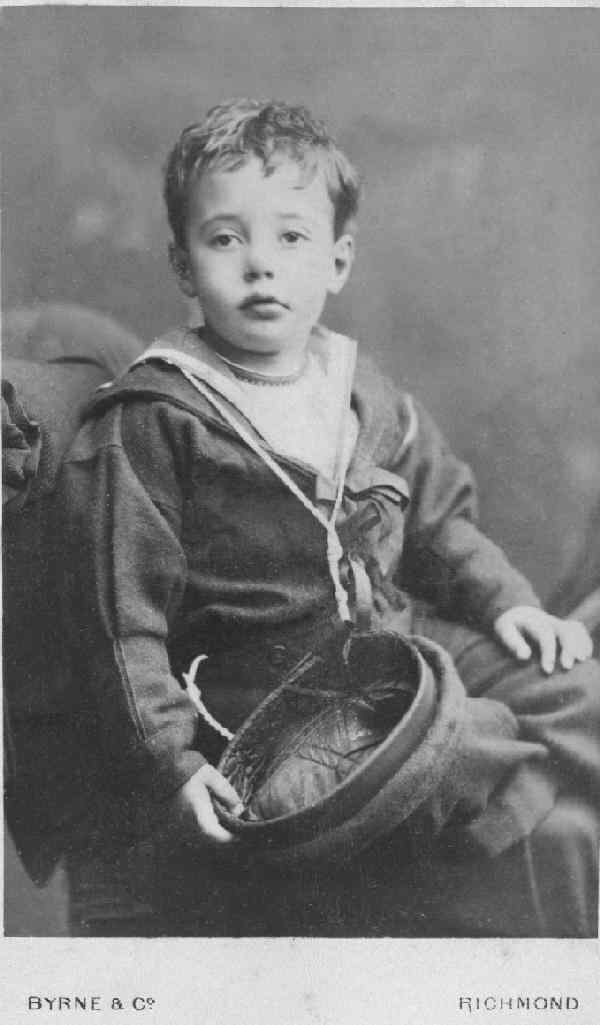
Photograpic Studios: Posing

Figure 1.--Unlike many studio photographers of the day, W.J. Bryne advised mothers not to dress children up in unfamilar clothes and to let their hair fall natuarally. Bryne produced both CDV and cabinent card images. Note the interesting view of the inside of the boy's sailor cap in this undated CDV. Image courtesy of the MD collection.
|
One interesting aspect of studio photography is the poses portrayed. Here the technology was a major factor. Early photographers were working with extremely slow speed plates. Long exposures wee rquired during which the subject could not move. This is why the poses are so uniformly stiff. It is also why the subjects is usually seated. There were also commonly stands in the back to hold the head still. In many portraits you can see the base of the stand. This is also why so many facial expressions are so solemn. It was difficult to hold a smile for an extended period. Modern observers often comment on how unhappy the children in these old portraits look and sometimes attribute it to their dislike of the often fancy clohing they are wearing. Much more likely is that the photographer discouraged them from smiling so a change in expression over the length of the exposure would not spoil the image. Of course this is a far cry from the modern photographer with fast film speeds who does his best to get the subjets, especially the children, to smile. An interesting aspect of old family portraits is who is responsible for the pose, the parents or the photograper. This is of interest as the pose suggests family relationships, a topic of some interest to HBC.
Stiff Poses
One interesting aspect of studio photography is the poses portrayed. Here the technology was a major factor. Early photographers were working with extremely slow speed plates. Long exposures wee rquired during which the subject could not move. This is why the poses are so uniformly stiff. It is also why the subjects is usually seated. There were also commonly stands in the back to hold the head still. In many portraits you can see the base of the stand. A good example here is a portrait of an American boy playing his viola. There are many other such images archieved on HBC.
Facial Expressions
The need for a long exposure is also why so many facial expressions are so solemn. It was difficult to hold a smile for an extended period. Modern observers often comment on how unhappy the children in these old portraits look and sometimes attribute it to their dislike of the often fancy clohing they are wearing. Much more likely is that the photographer discouraged them from smiling so a change in expression over the length of the exposure would not spoil the image. Of course this is a far cry from the modern photographer with fast film speeds who does his best to get the subjets, especially the children, to smile.
An interesting aspect of old family portraits is who is responsible for the pose, the parents or the photograper. This is of interest as the pose suggests family relationships, a topic of some interest to HBC. Here there are two considerations. First is the basic pose. Some HBC readers believe that this was primarily determined by the photographer. A HBC reader with an extensive collection of old photographs tells us, "As for the actual pose, I don't think the parents would have had that much control over that, though they would have told the photographer or chosen
from a sample album, the sort of picture they wanted. In which case, it shows either a lack of imagination on the part of the parents for choosing this pose, or a lack of imagination on the part of the photographer for not having more compelling and attractive poses to offer." HBC is sure that mothers played at least a minor role in the posing. There are, for example, too many ringlet cufrls carefully arrayed on a boy's shoulder so that they would be displayed for best effect for this to have been pure accident. (This is much less common for a girl's ringlets for some unknown reason.) Two is interactions
between the family members once the children are placed in the basic pose. In some portraits the children are touching or holding hands displaying rather tender relationships. In many other portraits the children stand stiffly, someties even with their hands held behinf their backs. Some HBC readers believe that this probably reflects instructiins from the photogfapher. We are unsure to ehat extent parents might be involved or to the extent that this shows formal relationships within the family.
The Studio Photographer
As in any profession, there were and continue to be great differences in photographers. Some were mere hacks churing out images with little attention to the art of obtaining true portraits. Others were real craftsmen with the ability to produce memorable portraits that truly reflected the subjects peronality. Some phtographers had a special way with children or even specilaized in portraits of children. Some have left us accounts of their work and approach to children which are helpful in our efforts to assess old photographs. One such photographer is W.J. Bryne who operated a popular Richmond (London suburb) photographic studio during the late 19th century. He specialized in photographing children and produced thousands of such portraits, both CDVs and cabinent cards.
HBC

Navigate the Boys' Historical Clothing Web Site:
[Return to:Main photographic studio page]
[Return to:Main photographic page]
[Introduction]
[Activities]
[Biographies]
[Chronology]
[Clothing styles]
[Countries]
[Topics]
[Bibliographies]
[Contributions]
[FAQs]
[Glossaries]
[Satellite sites]
[Tools]
[Boys' Clothing Home]
Navigate the Boys' Historical Clothing Web Site:
[Sailor suits]
[Sailor hats]
[Buster Brown suits]
[Eton suits]
[Rompers]
[Tunics]
[Smocks]
[Pinafores]
Created: April 29, 2003
Last updated: April 29, 2003



